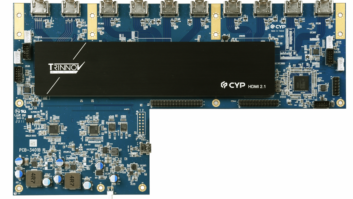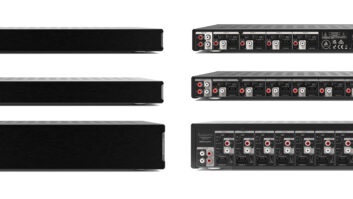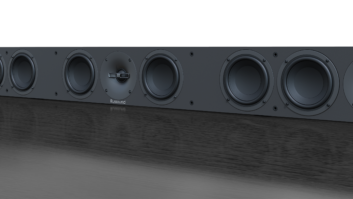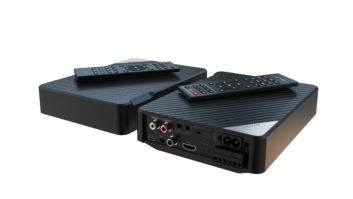Kudos: Great problem-solvers at attractive prices; offer loads of flexibility
Concerns: Fan noise on D1290; occasional lock-ups on AVA3.1; ARC audio compatibility
Sometimes, you don’t need a manufacturer to release a new product that reinvents the wheel; you just want one that kind of re-imagines it a bit to offer some additional flexibility or let you use it in a new and different way.
That’s exactly what Russound has delivered with the two units reviewed here: the D1290 multi-channel amplifier and the AVA3.1 Mini AVR.

Founded in 1967 in Newmarket, N.H., Russound has been making audio distribution products for the home and custom channel for more than 57 years. And while its recent product releases have been reliant on streaming, like its MBX audio system, or even voice control via Alexa, like its VoicePlay amplified keypad, these two products are decidedly “old school,” but with some nice new twists.
My company has been installing multi-channel amplifiers dating back to when we opened our doors in 1995, and they still play an important role in our whole-house installs. The flexible D1290 lands in a perfect price/performance sweet spot for those systems. The compact AVA3.1 is a perfect “multi-tool” solution to give you some flexibility for office and bedroom installs where space is at a premium, but the customer wants more than a soundbar.
D1290 First Impressions
I’ve reviewed tons of products, but it’s still a little surprising just how light many modern amplifiers that rely on digital technology are. Back in the day, a 12-channel amp could easily weigh 30-50 pounds, but here the D1290 tips the scales at just nine.
Straight off, I really liked the new industrial design of the D1290. It has a very clean front face, with a cool, textured graphite grey/black front faceplate and some tiny zone status LEDs. Since Russound intimately understands the nature of custom installs, making it so this 1U-sized component can either sit on a shelf or rackmount via included ears.
Around back, I loved the flexibility that Russound engineers delivered with the D1290. Along with discrete inputs for each zone, there are two BUS inputs that can be used to send signals to any/all the zones. If you’ve ever done a system with multiple large zones that have multiple speakers, you’ll appreciate this option and how it will help eliminate using Y-connectors.
Each zone also has a selector for running full-range 20 Hz–20 kHz (typical operation) or for engaging either a low-pass (LP) or high-pass (HP) filter. Russound says, “By customizing these audio filters, you can custom tailor the audio of the installation to maximize the performance of the amplifier [and] the efficiency of your speakers.” With the LP filter engaged, the amplifier will output from 20-160 Hz, which would be perfect for driving a passive subwoofer. With the HP filter engaged, the amplifier outputs 80 Hz-20 kHz, which would be helpful to not overdrive a small architectural speaker. I ran the D1290 in full-range mode for all my use.
While the 90 in the model name would indicate this is 90 watts per channel — which it is — this comes with a bit of a caveat. The unit is rated at 90 watts with one zone driven at 1 kHz into 4 ohms. It delivers 45 watts under the same conditions into a more common 8 ohms. You can also bridge any of the channels and get 180 watts into 8 ohms. Each zone also has a trim pot for adjusting the output.
As you’d expect from a CI-centric company, Russound also includes six pair of Phoenix connectors, a detachable IEC power cord, a 12-volt trigger in/out, and the ability to have the amp stay on all the time, auto turn-on when sensing a signal, or via the 12-volt trigger.
One note on the 12-volt trigger: When you open the box, there is an “Eco Friendly Operation” card that says, “Note: When used in ‘On’ mode or whenever a 12V trigger is used in ’12V’ mode, the amplifier will be fully powered on and will consume more energy.” This is incorrect. Both the 12V and auto setting use only 0.5-watt of power when in standby. Russound is aware of this printing error and is going to update the verbiage.
AVA3.1 First Impressions
The AVA3.1’s raison d’être is to power a traditional, passive 3.1-channel L/C/R speaker system in the smallest and simplest form-factor possible. This is a great solution for the customer wanting more performance or a different aesthetic than a soundbar offers but doesn’t have the space or need for a traditional AVR. With the included bracket, the AVR could be wall-mounted or it could be installed inside an in-wall enclosure behind a display like a VersaBox. (If a 2.1-channel stereo solution is all that’s needed, Russound offers the lower-priced AVA2.1, which is identical in every way, short of only having two channels.)

If the D1290 feels light at 9 pounds, the AVA3.1 is a total featherweight at just 1.5 pounds, so much so that it feels a bit “plasticy.” (Probably also because its outer case is made entirely of plastic.) The front of the AVA3.1 is spartan with just a single, multi-colored status LED. Around back, you’ll find all the connections needed to connect a modern system, including RCA analog, Toslink optical, and HDMI with ARC. There is also an analog mini-jack output and RCA subwoofer output, along with a mini-jack input/output for IR connections for use with the included IR receiver. Since the AVA3.1 doesn’t sit on the network, a USB-C service connection is available for any updates. To facilitate music listening, the AVA3.1 also includes a Bluetooth 5 receiver.
The AVA3.1 has a pretty modest power rating of 50 watts/channel at 1 kHz into 4 ohms; 25 watts under the same conditions into 8 ohms. In use, though, I found this had plenty of power to drive the small bookshelf/on-wall/in-wall speakers it is likely to be paired with.
Setup
I installed the D1290 in my existing home audio system, using it in place of my usual 16-channel Triad amplifier. Because I only have five zones of audio, I bridged two of the channels to drive the new Monitor Audio Creator Series C3L speakers in my bedroom to give them the most power. Other than making sure you have all the DIP switches set to the correct position, installing the D1290 is a simple and straightforward procedure.
The D1290 install manual poses a variety of install use cases, including pairing the 12-channel amp with a receiver or processor to power an 11-channel Dolby Atmos surround system. However, I fear the 45 watts/channel (8-ohm) wouldn’t be a great match for many systems, and likely wouldn’t be a step-up over the amplification included on any AVR that offers 11-channel decoding.
I initially installed the AVA3.1 in my home’s testing room, where I always have a variety of speaker systems and other electronics on hand. On making the connections, I noticed a bit of an oddity with the silkscreen printing above the speaker wiring terminals. Normally, you’d expect some sort of logic or pattern to the connections and color coding, such as +/–/+/–/+/–, however, the connections are +/–/–/+/+/– and to make it more confusing, the silkscreened colors aren’t consistent between + and –. While this obviously doesn’t affect performance, unless you mis-wire it, it did have me double-checking my connections!

After making the connections, I grabbed the AVA3.1’s remote and went to use the system. When nothing responded, I realized that the included infrared target isn’t optional or for use only when the AVA3.1 is out of sight, but rather required for it to receive commands. As a nit, the IR target is kind of cheap-looking. It is a bubble/dome design and not very discreet if you were to stick it to the front of a display. While other remote’s IR signals are meant to repeat through the AVA3.1 — say if the TV’s sensor is being blocked by a speaker — I couldn’t get this pass-thru to work. I tried three different makes/brands of IR emitters, and all of them immediately lit up full-red once they were connected, like they were being flooded by IR, and no signals would pass.
Next, I went to listen to some audio from my connected Sony TV. While the AVA3.1 and my Sony XR65X95K could see each other and were communicating via CEC — the TV flipped to “Audio System,” raised and lowered the volume level, and powered the AVA3.1 on/off — there was no audio. I tried rebooting the TV, using different HDMI cables, turning eARC on/off, but I could never get it to play any audio. I know the output works on the TV because I have tested a dozen soundbars with it (and reconnected one just to confirm it was still working).
I reached out to Russound, and they said that the AVA3.1 is compatible with ARC only, not eARC, and that it can only accept PCM 44.1 kHz/16-bit signals. This is another bit of oversight on the Russound manual, as “PCM” is never mentioned in the 15 pages. Also, the manual suggests, “Connect the HDMI cable to the HDMI Port on the TV labeled HDMI (ARC or eARC) and to the rear HDMI port of your AVA-Series mini-AVR labeled ‘ARC.’ It is very important that you connect to the ARC or eARC HDMI connection on the TV.” To Russound’s credit, after I brought this to its attention they are updating the online and printed manual to reflect this.
Review: Victrola Hi-Res Carbon Turntable
So, I went back into the TV settings, turned eARC off, set digital output to PCM, set bitstream pass-thru to off, and still couldn’t get any audio. As a fallback, I also tried connecting my TV’s Toslink output and couldn’t get any audio there either. Tired of fighting this war, I brought the AVA3.1 into my showroom and connected it to a different Sony TV (an XR55A80K OLED) and after changing the output to PCM it worked like a champ. Russound commented, “We’ve noticed at least two Sony models that have some issues and our engineering team is working on troubleshooting the settings so we can post some info online and in the manual for this.”
Performance
The D1290 worked exactly as it should, and using the music-sensing, auto turn-on, it woke up quickly and never had any issues. The amplifier trims come set to middle out of the box, and this was definitely quieter than my Triad amp, but after bumping these up a bit, volume levels were very similar. Music from the Monitor C3L’s sounded great, and I was able to coax some real bass from my 8-inch outdoor speakers. Even still, I felt that my ICE-powered Triad amp had better dynamics and punch.

Depending on the install location of the amp, there are a couple of things about the 1290 that might be an issue. For one, the front-panel LEDs are pretty bright with no way to dim/defeat them. When any amp channel is in use, all six front-panel LEDs illuminate in either red (inactive) or blue (active). If this is in a place where the amp is visible, it’s possible this light pollution could be disturbing.
More bothersome was the amp’s fan, which starts up after the amplifier has been playing for a bit and is clearly audible, even if audio is playing at a low volume. If I had my druthers, I’d rather there be no fan for silent operation, but if it is either have a fan or an amp that burns up, I’ll take the fan. Obviously, if this is racked away somewhere, it’s a non-issue, but in my install with the amp in my living room, it was distractingly noticeable.
After bringing the AVA3.1 into my showroom, it mostly worked like a champ. It would automatically wake up and power on/off with the TV, and then adjust volume using the TV’s remote control. This was the simple, get-out-of-the-way kind of performance most users would want from this product. And connected to Monitor Audio Radius LCR speakers and subwoofer, the audio performance was great, delivering plenty of volume. Throughout hours of watching, I never noticed any lip-sync or other audio issues.
And once paired to my iPhone, I found that the Bluetooth was quick to connect and had good range, letting me play music from my phone to the AVA3.1 from 50 feet away through multiple walls.
If you’re unable to use CEC to control the system, the included Russound remote can learn various commands from a TV remote, including power, input, volume, and D-pad control.
The Russound remote also offers access to four different DSP settings: Movie, Music, Voice, and Mega Bass. I found the manual’s descriptions of what these settings did a little confusing, for example Movie is described as enabling “a high-pass filter at 35 Hz, and a Box EQ at 240 Hz (–4 dB) and 860 Hz (–3 dB) to allow for dynamic response in movies and films,” and Voice as enabling “a high-pass filter at 100 Hz and a low-pass filter at 12 kHz to allow for more dialog detail and clarity.”
Russound offered some clarification, saying the 35 Hz filter in Movie mode is to prevent distortion or bottoming out, as many in-wall, in-ceiling, or passive soundbar speakers can’t handle frequencies below 35 Hz, and Voice mode uses a limiter to reduce frequencies outside the voice range to clarify the voice.
Fortunately, these filters don’t impact the signals output to a connected subwoofer, so if your system has the means of handling bass, you’ll still get it. But if you want to clear out all the filters and get a full, unadulterated 20 Hz–20 kHz audio signal, then go with Music mode. Mega Bass, which toggles an increase in bass by approximately 10% from 50–100 Hz, can be used with any of these modes, along with being able to tailor audio with bass and treble boosts/cuts.
Having said that, the Voice mode definitely helps with dialog clarity, and if users struggle with issues of understanding what is being said, this is a useful and helpful setting. And considering that this will likely be used in secondary listening rooms, where pure performance will take a back seat to ergonomics, I daresay that’s a good thing.
Music purists might be disappointed that there is no way to listen in just straight stereo, as the center channel speaker is always on, playing a mix of the left and right channels, and then giving priority to voice/dialog enhancement.
While the front-panel status LED does a triple-blink when receiving a command and changes color to display the current input (white for HDMI, green for optical, blue for Bluetooth, and cyan for analog), there is no indication of what DSP mode is selected.
If you noticed, I wrote that the AVA3.1 “mostly worked like a champ.” That’s because I had a few occasions where it locked up and wouldn’t power on or respond, either via CEC or from its remote, and one instance where it just stopped playing any center-channel audio. The resolution in all cases was to simply unplug it from power and power it back on, but that would be much easier said than done if it were located in a VersaBox.
These devices do exactly what I’d expect from Russound, offering solid performance, functionality, and features at competitive pricing. In fact, we’ve already installed a D1290 for one customer, and an AVA2.1 in the tight confines of a boat for another! For your next install that requires a little flexibility or is challenged for space, give these Russound amps a look.
603-659-5170; RUSSOUND.COM
Product Specs:
D1290
- 12 channels x 90 watts (4 ohms, @ 1 kHz, one zone)
- Channels bridgeable to 180 watts (8 ohms @ 1 kHz, one zone)
- All zones selectable inputs (Bus A, Bus B, Zone)
- Selectable outputs by zone to full-range (20 Hz–20 kHz), Low Pass (20–160 Hz), High Pass (80 Hz–20 kHz)
- Connections: Inputs: Ten RCA analog audio, 3.5mm 12 VDC trigger; Outputs: Six sets of Phoenix-style speaker connectors; 3.5mm 12 VDC trigger, removable power cord
AVA3.1
- 3 channels x 50 watts (4 ohms, @ 1 kHz, one zone)
- Bluetooth 5.0 audio streaming
- Four DSP modes including Mega Bass, Movie, Music, Voice
- Includes IR target and remote control
- Connections: Inputs: HDMI with ARC, Toslink optical, RCA Analog, mini-jack IR input, USB-C (Service); Outputs: Mini-jack for analog, RCA subwoofer, mini-jack IR out, Phoenix-style speaker connector, removable power cord
Dimensions:
- D1290: 17.125 x 1.75 x 9.75 inches (HxWxD); Weight: 9 pounds
- AVA3.1: 5.8 x 1.4 x 7.9 inches (HxWxD); Weight: 1.5 pounds







